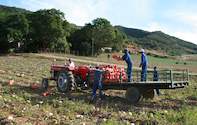
Plant Description
Butternuts are part of the cucurbit family of vegetables. Other cucurbits include marrows, cucumbers and pumpkins. They grow flat on the ground and the stems and branches develop into creeper vines.
The plant has large round heart-shaped leaves. The plant is monoecious, meaning that both male and female flowers form on the plant. Female flowers that produce the fruit are larger than the male flowers that don’t produce fruit.
The fruit is cylinder shaped and bulges at the end where the seed cavity is.
Uses
The mature butternut fruit can be eaten roasted, boiled and pureed for soup or processed and bottled or canned. It is a good source of fibre, is very nutritious and is rich in Calcium, Vitamin A, C and E.
The leaves and flowers can also be eaten as a vegetable on their own or combined with other vegetables or proteins.
Soil Requirements and Preparation
Butternuts, as with other cucurbits, like sandy loam to loam soils that are well drained and have a high level of organic matter. Soil pH should be between 6 and 6.8. If the soil is too acid, add lime to the soil prior to the first ploughing of the field.
Start preparing ground six weeks before your intended planting date. If there is compaction in the soil, then it is recommended that the field is ripped with a subsoiler to loosen the compaction.
If organic material or lime are required then the lime, compost and or manure is spread over the field and ploughed in at this time. The soil is ploughed to a depth of 300 mm to 400 mm to mix in the compost and lime. It is best to plough twice to mix the soil well.
The second ploughing can be done at a different angle to the first. Draw a harrow over the field to break up any sods and to level the surface. This also helps clear any weed debris from the field.
A few days before planting, the field can be finally disc harrowed to again clear weeds that may have started to grow and to smooth the surface. After this the plant lanes can be slightly ridged and smoothed or flattened to prepare a bed where the butternut seeds will be planted.
Climate
Butternut is a warm climate plant, so plantings are concentrated over the spring and early summer months. In South Africa this is from August to December. The plant is extremely sensitive to frost and long periods of temperatures below 4°C can kill the plants.
As long as the butternut plant’s growth period does not experience too many days of temperatures of over 35°C (this increases the formation of male flowers that do not bear fruit) or temperatures below 12°C (this slows or even stops growth and development), the butternut can be planted from as early as July to as late as February.
Optimum germination temperature is 20°C to 30°C and best growing temperatures are 22°C to 32°C during the day with night time temperatures no lower than 16°C.